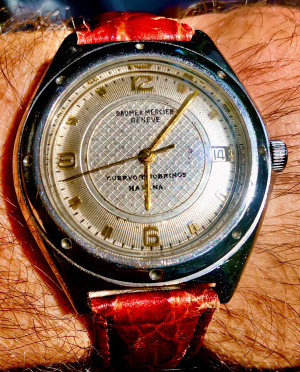Cuervo y Sobrinos: Difference between revisions
No edit summary |
|||
| Line 1: | Line 1: | ||
[[File:Baume cuervo lakemaster.jpg|thumb]] | |||
==BRIEF HISTORY OF CUERVO Y SOBRINOS HABANA WATCHES== | ==BRIEF HISTORY OF CUERVO Y SOBRINOS HABANA WATCHES== | ||
Revision as of 21:52, 4 June 2020

BRIEF HISTORY OF CUERVO Y SOBRINOS HABANA WATCHES
At the end of the 19th century, Havana, the pearl of the Caribbean, became a meeting place for intellectuals, businessmen and world figures, as well as adventurers and sailors. It was in this unique atmosphere that Armando Rio y Cuervo and his brothers ran the jewellery and watchmaking business founded by their uncle Ramon (hence the name, Cuervo y Sobrinos--"Cuervo and Nephews"). In the spring of 1882, the family opened its "La Casa" shop on Havana's prestigious Avenida Quinta (Fifth Avenue). As evidenced by the guest book and photographs that first came to the light only a few years ago, discovered in the basement rooms of the old La Casa shop, Ernest Hemingway, Enrico Caruso, Clark Gable, Winston Churchill and even Albert Einstein were among the Cuervo y Sobrinos shop's customers.
The brand-heritage was established in less than half a century. The marriage of watch quality with the brand's Latin spirit conquered the Americas. Several leading watch brands (Rolex, Patek Philippe and Longines) associated their names with that of Cuervo y Sobrinos to co-produce Havana timepieces. During the 1890s, Cuervo y Sobrinos expanded its production network and opened three other outlets in European capitals. At a time when most European luxury-product manufacturers were expanding to other continents, Cuervo y Sobrinos dared to go in the opposite direction. It successfully established itself on the Old Continent: at Pforzheim, Germany, in the heart of Paris, on Rue Mezlay, and at La Chaux-de-Fonds in Switzerland, where the watches were created. For its select clientele--international figures from the worlds of literature, science, film and politics--a stop at La Casa in the centre of Havana became as important as a visit to the great jewellers on Place Vendome in Paris or New York's Fifth Avenue.
During the 1940s, when the brand was at its peak, Cuervo y Sobrinos watches were not just high-end timepieces--they also represented a lifestyle and a way of thinking. Any dreams Cuervo y Sobrinos had of conquering the watch world however, were dashed by the Cuban revolution of 1959. Some of the Cuervo family sought exile in Europe and the business slowly fell into oblivion. For 40 years, the brand lay dormant, remembered only by connoisseurs.
